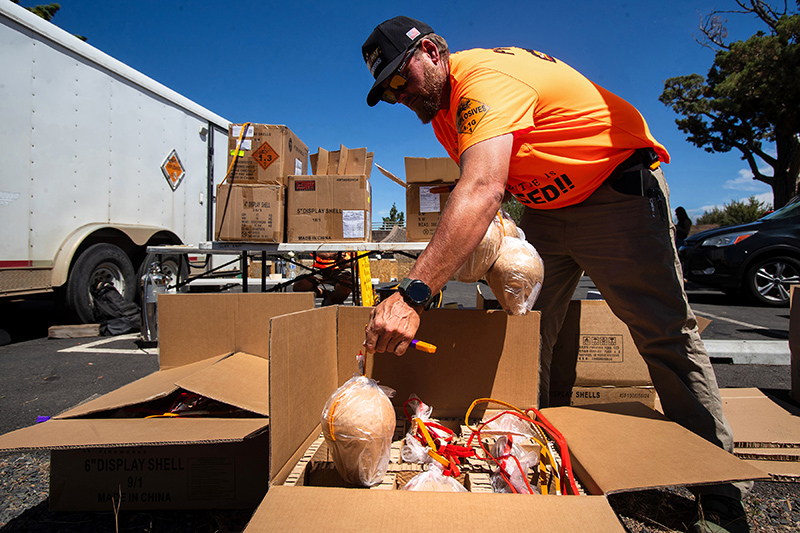Bend wedding takes place in kayaks in 1993
Published 12:00 am Sunday, July 8, 2018
Compiled by Don Hoiness from archived copies of The Bulletin at Deschutes County Historical Society.
100 YEARS AGO
For the week ending
July 7, 1918
Quentin Roosevelt killed behind the German lines
Dispatches from the front declare that Quentin Roosevelt, 22 years age, the youngest son of ex-President Theodore Roosevelt, was killed when his aeroplane was brought down in flames behind the German lines during a fight near Chateau Thierry Sunday.
Roosevelt fell within full view of the American trenches. He was returning from a patrol flight and suddenly lost control of his machine, having, probably, a mortal wound.
Father deeply affected
Theodore Roosevelt was deeply affected today when he was informed by the United Press of the death of his son Quentin. When asked for a statement he said in a weak voice, “Not a thing, not a thing.”
Later the former President stated that he was glad “that Quentin had a chance to render some aid to his country before his death.”
He declared that the death of his son would not change his plans.
City of queer contrasts
Ships approaching the coast of Alaska watch eagerly for the first glimpse of a break in the low horizon line, and as the faint silhouette of a city is caught by the spy glass, word goes around that Nome is in sight. The square outlines grow steadily plainer and broader. Unmindful of the heavy waves that crash so dangerously near its doors, the city is reaching out to the very water’s edge to greet the incoming ship. A bobbing launch comes out to meet the ship and bring in the passengers to the shore.
The gold seekers built Nome in the rush of 1898, and the gold seekers still add their quota to its population. They have made it a city of contrasts — of ostentatious wealth and hopeless desires. Where they camped on the beach and built wooden huts and saloons the city has grown up. When more space was needed, it spread its houses along the beach in long uneven rows,
From November to June it is frozen into a dull apathy from which it rouses to attend theaters, dances, and other social frivolities which make the winter tolerable. Ice bound and dark the winter may be, with only three or four hours of pale sunlight a day, but the popular idea of the wilds of Nome is an interesting myth. Electric lights, telephones, department stores, banks, hotels — Nome has all of these perquisites of modern civilization.
When the sun begins to shine steadily and the fresh surf pounds on the beach, Nome awakes and the summer residents who have gone “outside” return. The population is practically doubled. Nome spreads its summer months in wildly rushing about to make up for the enforced dullness of the frozen winter.
75 YEARS AGO
For the week ending
July 7, 1943
Colonel bails out of plane at 40,200 feet above Mt. Rainier to test equipment
Col. William Randolph Lovelace, head of the aero medical laboratory, has established that American fliers can bail out in safety from any altitude their planes can reach, by doing it himself from 40,200 feet.
Official records are not kept on the height of parachute jumps but so far as could be ascertained it was the highest U.S. army jump ever made.
Lovelace made the jump high over Mount Rainier and landed in a wheat field near Ephrata, Wash. His purpose was to test oxygen equipment which he developed and proved under laboratory conditions. The equipment stood the test, he reported. He came through his experience unhurt save for a frozen hand which is recovering.
“I don’t care to do it again,” Lovelace said of the record jump. Mount Rainier was far below, but still looking pretty big, when he left the big bomber that carried him aloft.
The Columbia River was a thin shining ribbon among mountains and a field of green. A fixed line opened his parachute with such a jerk that Lovelace was knocked out. His arms flew out and he lost three gloves off his left hand, a silk glove next to the skin, a woolen glove in the middle, and an alpaca glove on the outside.
His silk glove remained on the right hand and kept it from freezing. He was taken to a hospital and treated. His hand responded quickly.
Lovelace estimated that he regained consciousness at about 30,000 feet, though he was in a daze until abut 8,000 feet. His oxygen lasted until he reached about 15,000 feet. It took him 23 minutes, 51 seconds to descend.
Lovelace was testing bail out equipment consisting of a small cylinder containing 12 minutes supply of oxygen, sewn in his clothing, with a tube leading to the mask. The equipment was developed under Lovelace’s direction.
‘Silver meteors’ believed to be man-made objects
Another report of a “silver meteor” drifting over the Deschutes County came from Alfalfa. Another “meteor” was reported last week from Terrebonne.
The newest meteor seen in Alfalfa is believed to be some sort of drifting incendiary bomb released by enemy submarines off the Pacific coast.
The Terrebonne and Alfalfa “meteors” were observed on different days. In each instance, a search for some trace of the object revealed nothing.
50 YEARS AGO
For the week ending
July 7, 1968
‘Good old days’ — many have fond memories of earlier celebrations
The year 1933 should ring a bell for some people. That was the year Franklin D. Roosevelt was inaugurated as the 32nd President, prohibition officially ended, and Bend held it’s first July 4th water pageant.
But that year was only the beginning. Independence Day celebrations created some fond memories for Central Oregon residents in the years that followed.
Bend’s initial water pageant evolved from the usual July 4th mid morning street parade. Floats were constructed and admission of 25 cents bought you a seat.
A drifting covered wagon was the crowd pleaser for the 1933 debut and people began to realize they had the makings of a tourist attraction.
Years later the Mirror Pond pageant had become well known. An arch of colorful lights was constructed and people gathered from all corners of the state to view the extravaganzas.
The water parade took a wartime break from production in 1940, but resumed seven years later. In 1965 the aquaparade closed its history book, and has not been reopened.
There were other early-day events. One was the annual Benham Falls picnic. In 1923 railroad cars provided transportation and a tug-of-war highlighted the celebration.
An annual rodeo at O’Donnell Field created Independence Day excitement in the mid 1930s. Indians even came from Warm Springs to give the affair added western flavor.
Then there was the year of the “Great Race” from Redmond to Bend. A field of 20 contestants ran the grueling test of endurance in 1933.
One July 4th celebration featured a Salem-Bend Babes baseball clash. Another year a sky circus attracted residents, and one year the city presented “Dancing Waters.”
To some people those were “the good old days.” To some people times have changed. To some people July 4, 1958 will be a day to remember.
Well paid (editorial)
There has been occasional comment in these columns about the problems of college presidents. The job does have its problems, of course. But pay is not one of them.
The new president of Portland State will receive a salary of $32,500, plus a house, plus a $2,000 allowance for expenses next year. The same will be paid to presidents of the University of Oregon and Oregon State. The Dean of the University of Oregon Medical School will continue to get $35,500, plus $1,000 for expenses.
25 YEARS AGO
For the week ending
July 7, 1993
Skin-shy Sports Illustrated boots naked men
For most readers of Sports Illustrated, the swimsuit issue, with its photos of women in skimpy attire, is an annual pleasure. But the magazine’s editors have concluded that male flesh is “not suitable for publication.”
Word has been spreading this week that the magazine’s managing editor in New York rejected an advertisement intended for SI’s new Canadian edition. The ad features 11 naked soccer players — with soccer balls, trophies and hands placed very strategically. The young men are wearing only soccer shoes.
The advertiser isn’t happy. “There’s no more nudity there than Sports Illustrated runs in a boxing story,” said Steve Ralph of Adidas Canada Ltd., the company that originated the ad for soccer uniforms.
The models in the ad are members of a soccer team sponsored by Adidas. Ralph said company officials had extensively reviewed the ad, showing it to retailers, employees and consumers, before sending it to the magazine. They were aware it might be perceived as risqué but thought it was “fun,” he said.
Wed by love of water
No adults snoozed. No kids squirmed in their seats.
The guests at Tom and Laurie Ponte’s wedding Saturday were too busy hanging on for their lives — and most seemed to be loving it.
The Mississippi may be a mess, but the only flood on the Deschutes was an overflow of excitement.
“It was wild,” said a damp and tousled Chelsea Hogue, 11, and “much funner” than other weddings she’d been to.
Tom and Laurie agree. That’s why the self-proclaimed “swimming and paddling buddies” from Bend decided to tie the knot in their kayaks.
They said their “I do’s” hand-in hand floating down the Deschutes River. Friends and family bobbed alongside in seven rafts. Afterwards, everyone — from nieces and nephews to new parents-in-law — followed the couple down the Big Eddy rapids.
Luckily, there were no “guests overboard,” although the minister did lose his balance briefly during the kiss.
And Charlotte, the couple’s dog and ringbearer, had to swim from raft to kayak to deliver the rings.
Her bright yellow life jacket kept her safe, though, and in style. Orange life jackets were proper attire at the wet wedding. And instead of corsages, paddles were handed out.








